Download PDF via DOI:
https://doi.org/10.51480/compress.2024.7-1.702
Między rzeczywistością a manipulacją: rosyjskie media i propaganda z perspektywy mieszkańców okupowanego obwodu zaporoskiego
Between Reality and Manipulation: Russian media and propaganda from the perspective of residents of the occupied Zaporizhzhia region
Abstrakt
Abstract
Keywords
Introduction
On February 24, 2022, the Russian Federation launched an attack on Ukraine, and by the end of February to the beginning of March, Russians had occupied a significant portion of the Zaporizhzhia region. The population faced unprecedented challenges, including violence, persecution, the killing of innocent citizens by Russian soldiers, the destruction of civilian infrastructure, and the blocking of Ukrainian mobile communications and the internet. These actions by the Russian side led to an information deficit, which was intended to promote the spread of fakes and unreliable claims, ultimately creating fertile ground for the growth of Russian propaganda and disinformation.
However, Russian forces did not stop at merely blocking communication. Official reports documented severe persecution of Ukrainian journalists and the occupation of editorial offices. Research conducted by the independent nonprofit organization, the Institute of Mass Information (IMI), revealed that the complete blockade of Ukrainian broadcasting allowed Russian propagandists to construct an alternate reality within the temporarily occupied territories and disseminate Russian propaganda media (The Institute of Mass Information, 2023).
The situation in the temporarily occupied territories became even more complex in August 2022 when the occupation administration of the Zaporizhzhia region announced the holding of a pseudo-referendum in these areas with the aim of legitimizing their annexation to the Russian Federation. According to an official online media source of the Ministry of Defence of Ukraine, Russian propagandists received a specific task, which was to create staged narratives for Russian media. Additionally, plans were made to organize over 100 pro-Russian pickets, and these events were to be covered by Russian bloggers and journalists (АрміяINFORM, 2022).
According to research conducted by The National Resistance Center, established by the Special Operations Forces to train, coordinate, and scale movements against the occupation of Ukraine, the Russians failed to gain support from the local population. Consequently, after the pseudo-referendum, Russian forces intensified their persecution and killings of Ukrainian citizens in the temporarily occupied territory. In propaganda videos aired on Russian media, Ukrainians were portrayed as Nazis and fascists who were hindering the temporary occupation of the Zaporizhzhia region. However, propaganda was not limited to mass media; in schools, occupiers instructed students on how to identify pro-Ukrainian sentiments among residents and encouraged them to report such individuals directly. In cases of non-compliance or involvement in pro-Ukrainian activities, local residents were forcibly evacuated from the region in an undisclosed direction (National Resistance Center of Ukraine, 2022).
In the situation faced by the residents of the temporarily occupied region, it is crucial to understand their attitudes toward Russian media and propaganda. The aim of this article is to analyze the attitudes of residents of the temporarily occupied Zaporizhzhia region towards Russian media and propaganda and to identify the main themes of Russian propaganda,
The research also poses the following investigative questions:
1.What information sources did recipients typically use to obtain news and information about events in Ukraine before the occupation and during the occupation?
2.What topics did Russian information sources transmit in the temporarily occupied territory of the Zaporizhzhia region?
3.What strategies did residents of the temporarily occupied region employ to distinguish truthful information from propaganda?
4.What were the primary factors influencing residents’ choice of information sources in temporarily occupied areas and their ability to critically assess information?
These research questions aim to help understand how the level of access to various information sources impacts residents’ behaviors towards Russian media and propaganda, as well as the factors influencing their ability to evaluate the credibility of information and to provide insights into the information landscape and the impact of Russian media in the context of the Zaporizhzhia region’s temporary occupation.
Literature review
To achieve political and territorial control over the Zaporizhzhia region, the Russian side employed a specific strategy (National Resistance Center of Ukraine, 2022):
1.Deployment of troops into the region.
2.Establishment of occupation administrations where key positions are held by representatives from Russia, and collaborators occupy mid-level positions.
3.The use of repression and bribery to maintain control.
4.Attempts to simulate widespread support.
5.Conducting a “referendum” with the aim of legitimizing the occupation.
Before the onset of the occupation, it can be confidently stated that the Zaporizhzhia region had a developed democratic society. According to research, an inherent element of a democratic society is public opinion. Characteristic factors of public opinion include freedom of speech, the functioning of non-dependent media outlets, and well-developed principles of social responsibility in governance (Ziółkowski J, 2012:133).
However, with the beginning of the occupation, the situation changed. Representatives of the Russian occupation authorities attempted to forcibly coerce Ukrainian journalists into cooperation. Mass terror began, journalists were subjected to repression and persecution, and threats were often directed at them. In this way, Russian occupiers sought to intimidate media representatives and compel them to disseminate Kremlin propaganda. Such actions constitute a direct violation of press freedom, and the Russian side breached the Hague Conventions and Declaration, the Geneva Convention relative to the Protection of Victims of War and its Additional Protocols, and the Convention on the Laws and Customs of Land Warfare, which provide security guarantees for journalists (Ukrainian Parliament Commissioner for Human Rights, 2022).
Based on the information presented above, it can be concluded that on the temporarily occupied territory of the Zaporizhzhia region, the Russian occupation authorities commit serious violations of journalists’ rights and international standards regulating conflict situations and human rights. In the current conditions, public opinion has no place to exist. Citizens are not granted the right to express their views and judgments, and even public opinion polls are subject to doubt. In light of these blatant violations of journalists’ rights and international standards regulating conflict situations and human rights on the temporarily occupied territory of the Zaporizhzhia region, it becomes evident that citizens are being deprived of their fundamental rights to freely express their beliefs and access independent sources of information. This situation not only constitutes a breach of international norms and agreements but also raises serious concerns regarding the respect for human rights and the principle of press freedom. In the presence of such control and propaganda by the occupiers, it is challenging to speak of genuine media freedom or public expression of opinion. This represents a clear challenge to the principles of democracy and human rights that underpin democratic and developed societies.
In addition to this, the Russian side employs information propaganda to influence public opinion and create conditions for support of the occupation regime.For the purposes of this work, a definition has been adopted in which propaganda is understood as „the deliberate, systematic attempt to shape perceptions, manipulate cognitions, and direct behavior to achieve a response that furthers the desired intent of the propagandist” (Jowett, O’Donnell, 2012). It should be noted that because propaganda is an institutionalized form of communication, its senders can include political parties, political elites, governments, and socio-political organizations, among others (Dobek-Ostrowska, Fras, Ociepka, 1999).
Andrew Wilson, a researcher at the Aspen Institute, has categorized Russian propaganda into several categories. For example, the first category aims to create a state of paralysis through the use of propaganda. Another category focuses on influencing individuals who already hold established worldviews characterized by anti-system tendencies, guiding them in advantageous directions. For the purposes of this article, we will be interested in the category whose goal is to create an alternative reality where a specific media narrative is supported by political parties, non-governmental organizations, media outlets, and religious institutions. In this category, all entities follow the same narrative, and this narrative gains additional credibility through practical implementation (Helmus & Bodine-Baron & Radin & Magnuson & Mendelsohn & Marcellino & Bega & Winkelman, 2018).
Ilya Nuzov, Head of the Eastern Europe and Central Asia Desk for the International Federation for Human Rights (FIDH), asserts that over the past two decades, Russian political elites have actively utilized memory laws to strengthen and nationalize their historical narrative, centered around the cult of war, particularly the Great Patriotic War (Nuzov, 2022).
These narratives are employed not only in domestic but also in foreign policy of the state. For the purposes of this article, we will be interested in external propaganda aimed at residents of other countries. According to research, Russian propaganda in media campaigns uses propaganda techniques commonly known and tested during Russia’s wars with other states, such as the Russo-Georgian War: disinformation, dehumanization, stereotyping, etc. (Yuskiv & Khomych, 2017).
The Media Literacy in Ukraine’s Regions project analyzed and identified the main themes that the Russian side promotes in the temporarily occupied territories:
1.Russia and Ukraine are one people and one country.
2.Ukraine left the Zaporizhzhia region without any protection or means of survival.
3.Western countries are enemies who want to destroy Russia and the Zaporizhzhia region (Media Literacy in Ukraine’s Regions, 2022).
However, such actions do not necessarily lead to the mass indoctrination of the population. Timothy Frye emphasizes the fact that recipients often choose which source to trust and why. Therefore, exposure to propagandistic information does not necessarily result in full agreement or the acceptance of presented propagandistic ideas (Frye, 2021). In the temporarily occupied territories, residents had a choice between Russian and Ukrainian media, which is why propaganda did not yield the desired results for the Russian side. This is precisely why the Russian side began employing specific tactics to achieve the goals set by the Kremlin.
The first technique is intimidation. The Russian side constantly threatens Ukrainian residents, recommends renouncing Ukrainian citizenship, and taking Russian passports. Otherwise, dissenters will be sent to prison, deported to an unknown destination outside the region, or their children may be taken away.
Another popular technique is that of so-called “closed doors”. The Russian side deliberately creates problematic situations for residents of the temporarily occupied territory, only to later resolve them themselves. For example, Russian propaganda may portray obtaining a Russian passport as a favorable option, even if many of the services and benefits provided to citizens with Russian citizenship were actually available in Ukraine before the conflict.
In addition to the intimidation techniques used on residents of the temporarily occupied territory, there is also the bombardment with incentives method. This includes offering various privileges, advantages, or special offers to those who acquire Russian citizenship. Russian propaganda creates the impression that obtaining Russian citizenship will provide more opportunities, benefits, and security. Such a strategy can influence residents’ decisions to accept Russian citizenship (MediaSapiens, 2023).
Such propaganda actions aim at sabotage and ideological subversion by Russia as the aggressor state within Ukraine as the victim state. The goal is to create a conducive environment for the aggressor that may lead to a change in an unfriendly political regime. This approach takes into account both military and non-military means and is conducted by various entities, including special forces, intelligence and counterintelligence, media, etc. Furthermore, if non-military means fail, the Russian side considers using conventional military means to achieve its objectives (Darczewska, 2015).
In the literature review chapter, the main issues related to Russian propaganda in the temporarily occupied areas of Ukraine, with a particular focus on Zaporizhzhia, were discussed. It was identified that Russia employs various propaganda techniques to shape narratives, manipulate perceptions, and influence the behavior of the population in these areas.
Analyzing research and reports from various sources, it was found that Russian propaganda seeks to create an alternative reality where a Russian national narrative is promoted as dominant while portraying the West as an adversarial force. Various propaganda techniques, such as disinformation, dehumanization, and stereotyping, were also presented as being used by Russia in its propaganda campaigns.
However, research also suggests that the population in Zaporizhzhia refion is not uniformly susceptible to propaganda. They choose which information source to trust, indicating that not all propaganda attempts are successful. It is worth noting that residents have access to various sources of information, including both Russian and Ukrainian media, which influences differences in perception and beliefs.
It is also important to note that Russian propaganda aims to undermine Ukraine’s stability and sovereignty while creating favorable conditions for a change in the political regime towards one more aligned with Russia. This propaganda operates on both military and non-military fronts, with Russia being prepared to use conventional military means if other methods fail.
Methodology and its challenges
In the study, a qualitative online survey was used as the research method. The choice of this method was deliberate and aimed at obtaining extensive written responses to open-ended thematic questions. This method was selected because of its ability to capture the richness of participants’ perspectives and experiences related to topics concerning Russian propaganda in the temporarily occupied territory of the Zaporizhzhia region. The questions were carefully crafted to uncover opinions, experiences, and narratives on subjects related to Russian propaganda in the temporarily occupied territory of the Zaporizhzhia region.
Open-ended questions were presented to participants in written form. Participants were kindly asked to provide detailed responses to these questions to clarify their perspectives or experiences. This format was chosen for its convenience and accessibility, allowing participants to respond freely at their own convenience and location. Each participant received a set of questions related to topics concerning Russian propaganda. This approach resulted in a diversity of responses, ranging from concise to elaborate answers to the posed questions. This method provided the opportunity to capture the diversity of perspectives and experiences of each respondent (Braun et al., 2020).
Participants
When choosing a methodology that aligns with the research objectives, careful considerations were made regarding the sample, as well as precise procedures and measurements. Sufficient information has been provided for reproducibility and confidence in the results. The study involved 30 participants ranging in age from 18 to 65 years who resided in the Zaporizhzhia region both before and during its occupation. It should be emphasized that each participant left the occupied territory. This indicates that the participants have a rich experience and firsthand knowledge of life in this region during different periods, making their opinions and accounts particularly valuable for understanding the political, social, and cultural dynamics in this context. This contributes to the additional reliability and adequacy of the obtained data.
The decision to work with a limited number of participants in the research is explained by the complex situation in the temporarily occupied Zaporizhzhia region. Some of the individuals invited declined to participate out of concern for the safety of their loved ones and family members who remained in the occupied territory. This context posed numerous challenges that influenced the methodology and scope of the study. It underscores the deeply personal and sensitive nature of the topic being investigated. It is evident that the current turbulence and uncertainty in the region have compelled people to prioritize the safety of those they hold dear, which is entirely understandable in these circumstances.
Due to the ongoing occupation of the Zaporizhzhia region, a crucial decision was made to ensure the anonymity of research participants. This decision was taken to safeguard the safety and confidentiality of participants, given the sensitivity of the current situation in the region. This step guarantees that neither the names nor any personal data of the participants will be disclosed or used in the context of the research. Such an approach not only protects the participants’ data but also creates conditions for more open and honest responses to the survey questions. Additionally, this method enabled access to a broad group of respondents and the acquisition of a diversity of perspectives, which is a valuable aspect of qualitative research. Also, anonymity often encourages participants to be more candid and open in their responses. This is particularly important when studying topics where individuals might have concerns about sharing their views openly.
Overall, the chosen methodology allowed for the collection of valuable insights into the perceptions and experiences of individuals in the temporarily occupied Zaporizhzhia region regarding Russian propaganda, taking into account the complexities and sensitivities of the region’s current situation.
Findings
In the initial phase of the study, participants were asked whether they considered themselves capable of distinguishing reliable information from misinformation. This provided an initial self-assessment from each participant on this matter and allowed for a subsequent comparison with their actual ability to differentiate information.
Figure 1. Do you consider yourself capable of distinguishing reliable information from misinformation?
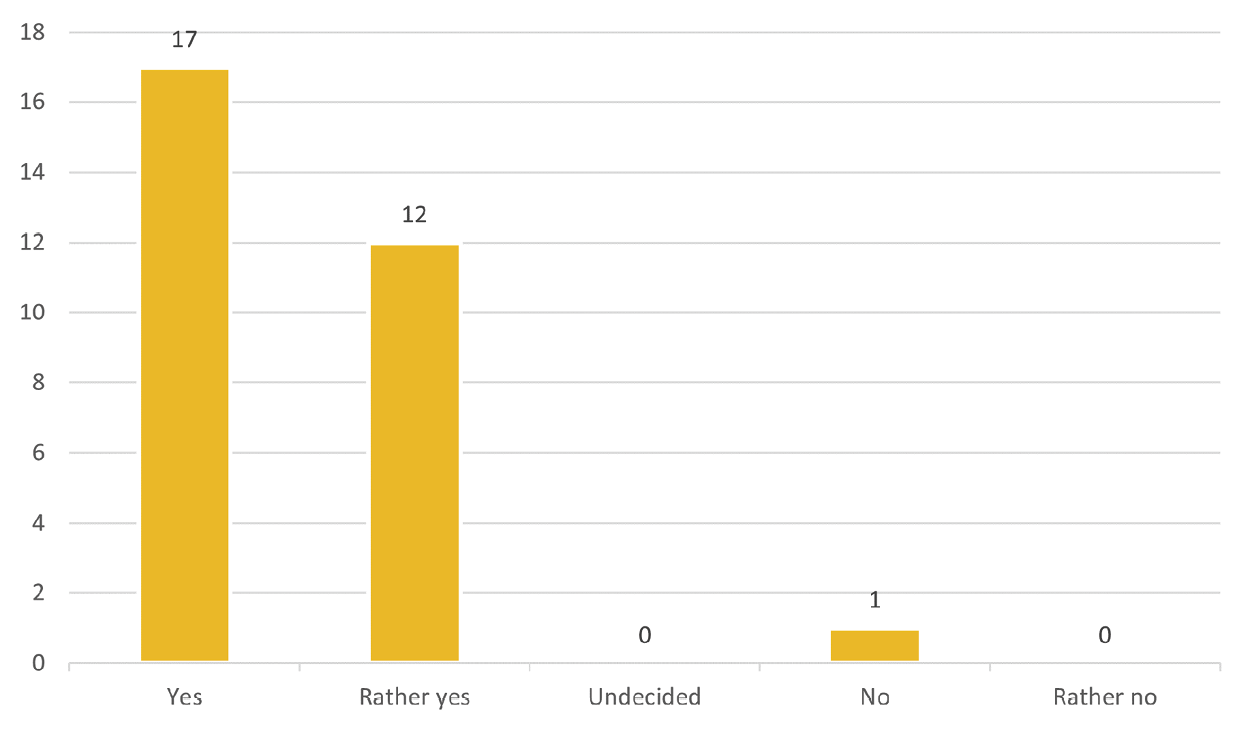
Based on the figure, it can be concluded that 17 respondents believe they can distinguish reliable information from false information, while only 1 respondent believe they lack this skill.
Next, a question was asked to determine which types of information sources were most popular among participants before February 24, 2022. This helped analyze the preferences of participants in obtaining news and information, as well as identify factors influencing the choice of sources.
Figure 2. What sources of information did you typically use to acquire news and information about events in Ukraine before the occupation?

Respondents had the opportunity to select more than one answer to this question. According to the data obtained, one of the most popular sources of information is Internet websites, news services, and platforms, with the majority of participants indicating them as their primary source of information. This choice highlights the significant role of the internet in information dissemination.
The results of this study emphasize the importance of diverse information sources in the lives of participants before February 24, 2022. According to the data, Internet websites, news services, and platforms became some of the most popular sources of information, with the majority of participants selecting them as their primary source. This indicates the substantial role of the internet in delivering news and facts.
It is important to emphasize the role of television in the lives of the study participants, with 19 of them inclined to trust television. It may indicate that television retains its role as one of the most reliable sources of information. In the third position are social media and communication services. Despite Internet websites, news services, and platforms occupying the top spot, participants are less trusting of information disseminated through social networks. While television is in second place, printed publications and radio are the least popular sources among participants.
Furthermore, it was necessary to identify the factors that influenced the choice of these media sources by the participants. The reasons for selecting information sources varied:
1.Current and reliable information (48.1%): For most participants, the chosen information sources were considered truthful because they provided current and reliable information that was later confirmed.
2.Traditional information source (14.8%): Television remained the primary source of information for those participants who were accustomed to receiving news exclusively through this medium.
3.Official sources of information from the Ukrainian government (11.1%): Participants chose only those information sources that provided the official government perspective on events in Ukraine and the world.
4.Independent sources (11.1%): Participants did not turn to TV and radio because they believed that a certain number of channels were owned by oligarchs or politicians and were biased. Printed publications had no informational value for them because of the internet, where information appears faster.
5.Sources opposing the government (7.4%): Participants chose opposition sources of information because they considered them more independent and unbiased compared to official sources from the Ukrainian government.
From the information presented above, it can be concluded that before the full-scale war and occupation of the Zaporizhzhia region, participants used information sources that aligned with their worldviews, were easily accessible, and convenient to use. However, for the purposes of this research, the interest lies in understanding which information sources recipients typically used to obtain news and information about events in Ukraine during the occupation.
Figure 3. What sources of information did you typically use to acquire news and information about events in Ukraine during the occupation?
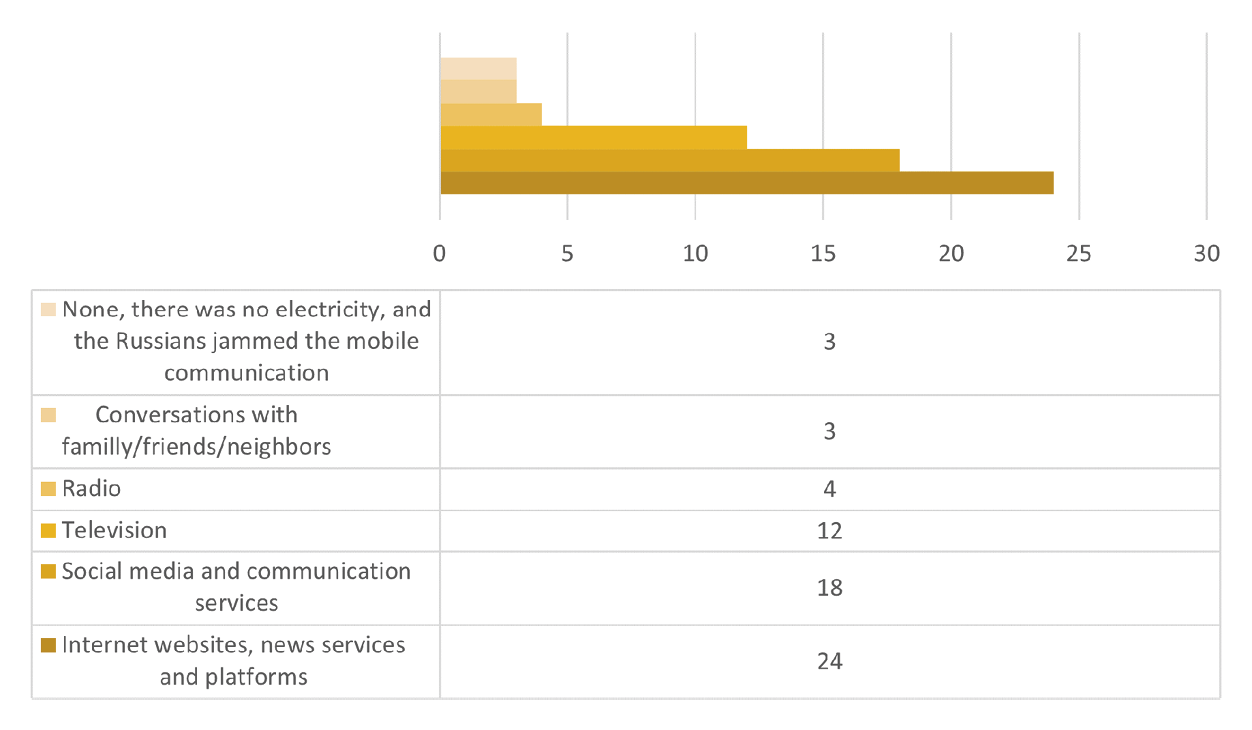
Participants had the option to select multiple answers or add their own. As can be seen, the primary source of information remained the internet. The second-place was taken by social media and communication services. It’s noteworthy that with the onset of the occupation, a significant portion of respondents began to receive information through the Telegram platform. Participants explained these changes by the fact that despite poor mobile network coverage and the lack of internet access, Telegram remained an accessible source of information. This may indicate that the platform played a crucial role in ensuring the free flow of information and communication under the constraints imposed by the occupation. Traditional media, such as television, dropped to third place. This situation can be explained by the fact that due to the lack of electrical power, respondents did not always have access to television.
In situations where respondents did not have access to television and the internet, radio served as a means of communication. This allowed participants to stay informed about current news, analysis, and events in Ukraine. When there was no access to the primary sources of information, respondents turned to friends and acquaintances to get firsthand information or to exchange opinions and interpretations of what was happening. Under the conditions of occupation, the Russian side created significant obstacles to obtaining information. According to respondents: “Russians could not control the truthful information provided by Ukraine, so they simply decided to deprive us of the opportunity to see the news at all”. These factors further underscore the importance of alternative sources of information, such as conversations with acquaintances and the use of the Telegram platform.
According to respondents’ opinions, the Russians began jamming mobile networks and the internet to isolate the citizens of Zaporizhzhia from Ukraine. The inability to access reliable information or communicate with loved ones is frustrating and leads to doubts that Ukraine is doing anything to liberate the temporarily occupied territories. According to the respondents, people who are disoriented and lonely are easier to manipulate: “Isolation is one of the aspects of violence used by Russians. The inability to get reliable information or communicate with loved ones is frustrating and makes people doubt that Ukraine is doing anything to liberate the temporarily occupied territories. Confused and lonely people are easier to manipulate”.
Moreover, the individuals interviewed highlighted in their responses that the Russian authorities were attempting to isolate the residents of Zaporizhzhia to limit communication channels and prevent the disclosure of the movements of Russian military personnel and equipment. As one respondent expressed, “Information is a weapon. They didn’t anticipate our resistance and sought to diminish it”.
Figure 4. In situations where access to Ukrainian sources was not available, did you utilize Russian sources of information?
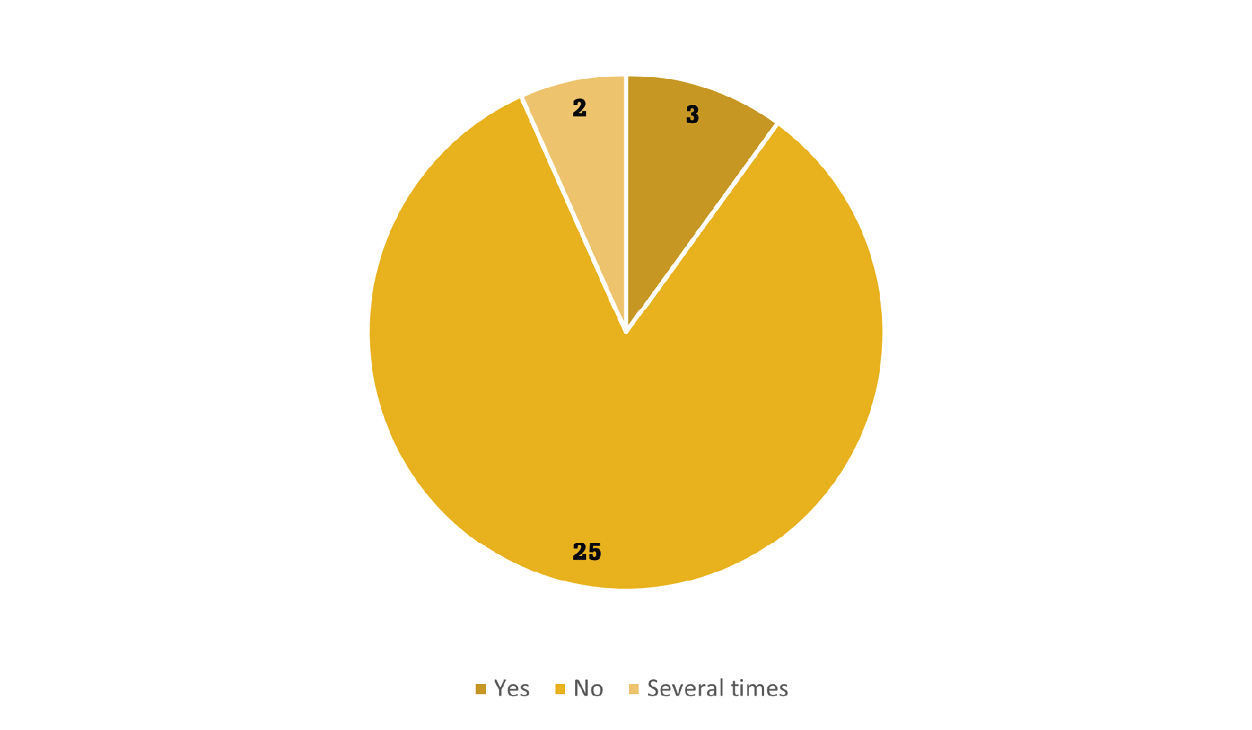
The overwhelming majority of respondents did not use Russian sources of information at all. According to the respondents’ opinions, this position was influenced by two factors:
1.Distrust of Russian media: According to the respondents, Russian media were seen as nothing more than propaganda for the regime, promoting biased views and deception.
2.Negative reaction to anything related to Russia: According to their responses, Russian sources of information only elicited a negative reaction.
The study also revealed that some participants did use Russian sources of information. In their responses to the question “Why did you use Russian sources of information?” respondents emphasized that using Russian sources made it easier to analyze information, especially regarding the situation in the temporarily occupied territories. However, according to their answers, respondents could not rely on Russian sources of information for an extended period due to the obvious propaganda and dissemination of false information. A respondent articulated that “It is very distressing to live in an information vacuum when you don’t know what is happening outside. And we couldn’t watch longer and more often Russian media, because it’s impossible to listen to it. Propaganda and false information are very obvious”. Very often in their responses, participants used the term “propaganda”. That’s why participants were asked to provide their own definition of this concept. According to the responses, the main characteristics of propaganda, as identified by participants, include “the dissemination of a specific ideology, concepts, beliefs, manipulation, and disinformation”.
Figure 5. In your opinion, are Russian information sources used by the Russian authorities to spread propaganda?
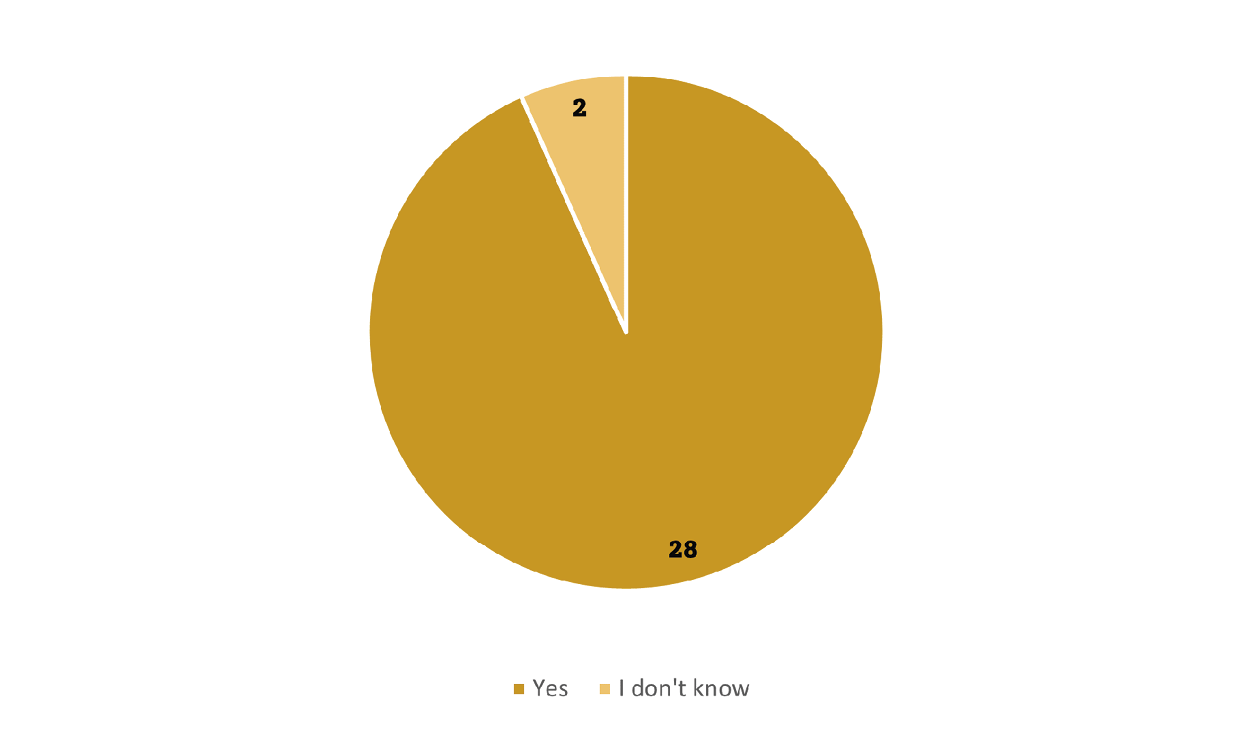
For the purposes of the study, a crucial question was whether respondents believed that Russian sources of information were used by the Russian government to promote propaganda narratives. It can be observed that the overwhelming majority of participants believe that Russian information sources can be used by the Russian authorities for propaganda purposes. It can be concluded that respondents associate the concept of propaganda with Russian information sources.
Figure 6. Do you have the impression that Russian propag`anda provides a distorted interpretation of real events?
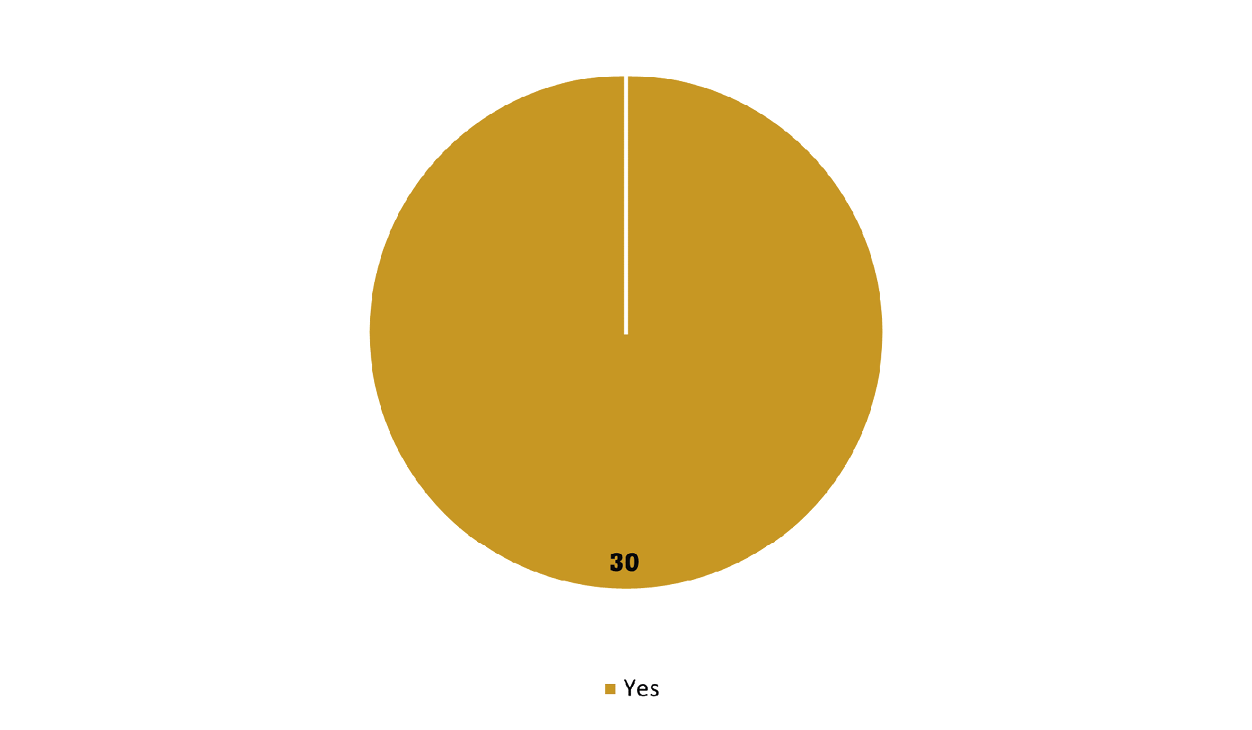
Figure 7. Do you think that Russian propaganda has a strong presence in the information environment of the temporarily occupied Zaporizhzhia region?
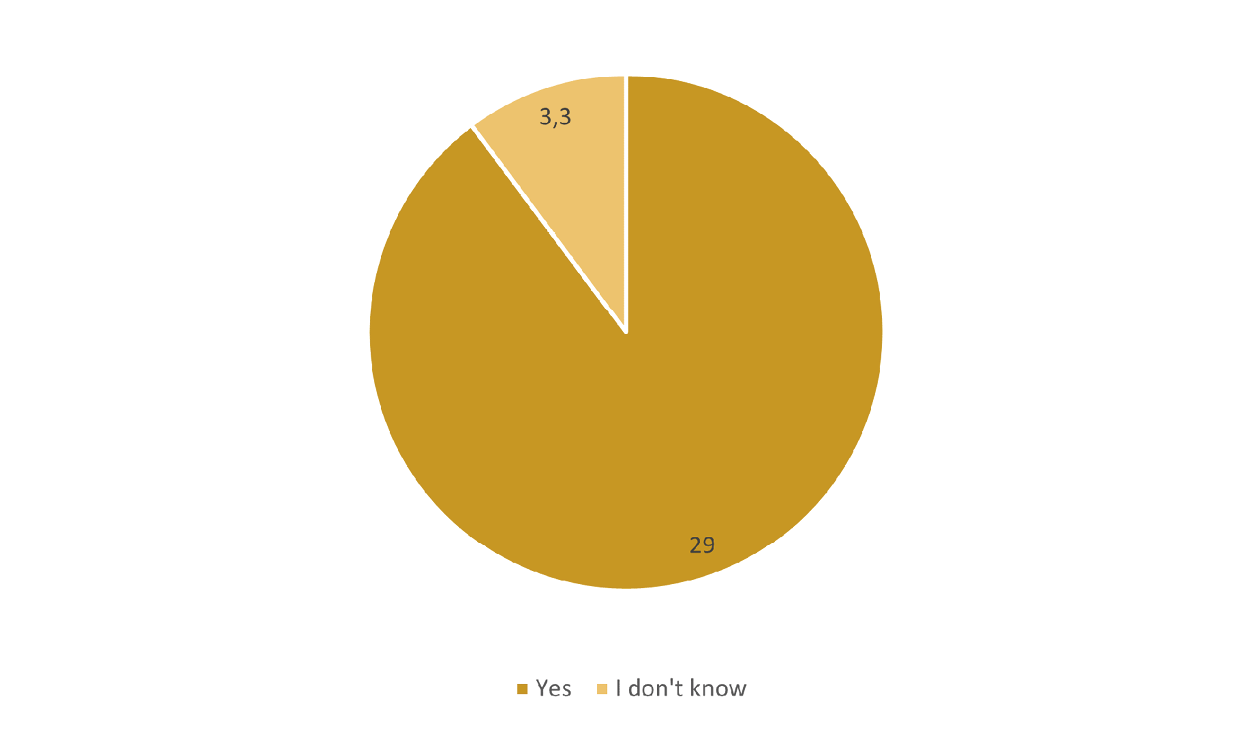
Despite the fact that 2 respondents had used Russian sources of information at least once, all participants unanimously believe that Russian information sources are used by Russian authorities to disseminate propaganda. According to the majority of participants, Russian information resources deliberately distort information and provide a biased interpretation of real events in order to support the Russian propaganda point of view. One participant remarked: “The Russians were given free newspapers, which contained information that was not true. They even turned what I knew to be 100% true in their favour, and always blamed Ukraine for it”. Next, participants were asked to provide specific examples of Russian propaganda that, in their opinion, Russian information sources transmit in the temporarily occupied territories of Zaporizhzhia region. Based on the responses, a list of frequently mentioned themes related to Russian propaganda in the temporarily occupied territories of Zaporizhzhia region was compiled:
1.Ukrainian Nazism: The belief that the Ukrainian government is controlled by Nazis who want to destroy Russia and the Russian people.
2.Ukraine initiated the war: The idea that Ukrainian “Nazis” intended to attack Russia, prompting Russian troops to enter Ukrainian territory to prevent this.
3.Russian soldiers as liberators: The notion that Russian forces are in Zaporizhzhia to protect it from Ukrainian “Nazis” because it is historically Russian land. Also, the idea that the Russian army continues the legacy of the Red Army in liberating the world from Nazism.
4.“Russia is here to stay”: The quote “Russia is here to stay”can be interpreted as part of the Russian propaganda narrative aimed at creating the impression of Russia’s long-term and unwavering presence in Zaporizhzhia.
5.Ukraine and the entire world betrayed Zaporizhzhia: This assertion may emphasize the role of Ukraine and countries supporting Ukraine in worsening the situation in Zaporizhzhia after the start of Russian occupation.
6.Prosperity in Zaporizhzhia is only possible within Russia: The idea that joining Zaporizhzhia to the Russian Federation will lead to improved economic well-being and social stability for its residents.
7.Discrediting the Ukrainian Armed Forces.
8.The belief that the Russian army has “no losses” and will soon win the war.
Finally, as part of the research, participants were asked how they distinguish Russian propaganda from other types of information. This question is crucial for understanding the criteria and indicators people use to analyze and evaluate the information they receive. From the responses, several strategies were identified that participants use to distinguish propagandistic information:
1.Refrain from consuming Russian sources as well as “independent” Russian sources.
2.Analyze information from multiple sources.
3.Consider the emotional tone of the content, as propaganda often contains emotional appeals to the consumer’s feelings.
4.Treat facts as facts, without giving them their own emotional interpretation.
5.Verify facts in independent sources, pay attention to the tone and emotional content of the message, and look for any generalizations or biases in the text
These strategies serve as valuable tools for empowering individuals with the ability to exercise discernment, critical thinking, and informed judgment when seeking out and appraising information. This skill set becomes exceptionally vital in environments where propaganda and misinformation are pervasive, enabling individuals to navigate such challenges effectively.
Conclusions
This study aimed to analyze the views of residents of the temporarily occupied Zaporizhzhia region on Russian media and propaganda, as well as to identify the factors influencing their opinions and beliefs. The results of the study showed that with the onset of the occupation of the Zaporizhzhia region, residents changed their approach to sources of information. The main criteria for selection became accessibility and credibility of information. However, during the occupation, these criteria changed, and respondents became more cautious and critical of the information that reached them.
The violent isolation of the population by Russian occupiers did not lead to a change in respondents’ attitudes toward Russian information sources. In situations where there was no access to Ukrainian media, respondents preferred to get news from family and acquaintances rather than reading Russian media. For the residents of the Zaporizhzhia region, Russian sources of information are associated with propaganda.
Respondents pointed out that the goal of Russian propaganda is to spread a specific ideology, beliefs, as well as manipulation and disinformation. The research findings showed that key themes of Russian propaganda in the occupied territories of Zaporizhzhia include claims that Zaporizhzhia will forever remain a territory of the Russian Federation, that Ukraine and the international community have abandoned this region, as well as manipulation of events, creating a positive image of the Russian Federation, and constructing internal and external enemies of Zaporizhzhia.
These responses align with the findings of the “Media Literacy in Ukraine’s Regions” research, confirming that these themes can be widely disseminated and accepted in the occupied territories and can serve as key elements of propaganda. The study revealed that residents have developed their own strategies to help them distinguish genuine information from propaganda. This is an important element of their media literacy and critical thinking.
The results of this study provide valuable insights into the activities of Russian media and propaganda in the occupied territories. Therefore, it is crucial to continue conducting research for a deeper analysis of Russian propaganda. As a result, this can contribute more effectively to information independence and literacy, as well as to counteracting the influence of propaganda.
Therefore, it is important to continue research for a deeper analysis of Russian propaganda and effective countermeasures to its influence, which can contribute to increasing the information independence and media literacy of residents.
References
Braun V, Clarke V, Boulton E, et al. (2020) The online survey as a qualitative research tool. International Journal of Social Research Methodology 24(6). Informa UK Limited: 641–654.
Darczewska J (2015) The devil is in the details. Information warfare in the light of Russia’s military doctrine. Available at: https://www.osw.waw.pl/en/publikacje/point-view/2015-05-19/devil-details-information-warfare-light-russias-military-doctrine (10.01.2024).
Dobek-Ostrowska B, Fras J, Ociepka B (1999) Teoria i praktyka propagandy. Wydaw. Uniwersytetu Wrocławskiego.
Ellick A, Westbrook A, Kesse J (2018) „The Seven Commandments of Fake News”. Available at: https://www.nytimes.com/video/opinion/100000006188102/what-is-pizzagate.html (10.01.2024).
Frye T (2021) Weak Strongman: The Limits of Power in Putin’s Russia. Princeton: Princeton University Press, pp. 144-147.
Helmus T & Bodine-Baron E & Radin A & Magnuson M & Mendelsohn J & Marcellino W & Bega A & Winkelman Z (2018) Russian Social Media Influence: Understanding Russian Propaganda in Eastern Europe. Available at: https://www.researchgate.net/publication/324480070_Russian_Social_Media_Influence_Understanding_Russian_Propaganda_in_Eastern_Europe (10.01.2024).
Jowett G and O’Donnell V (2012) Propaganda and Persuasion (5th ed.). London: Sage.
Kaźmierczak D (2017) Walka informacyjna we współczesnych konfliktach i jej społeczne konsekwencje. Studia de Securitate et Educatione Civili 7 (2017):112-113.
Media Literacy in Ukraine’s Regions (2022) “Одін народ, єдіная вєра” та інша російська пропаганда на території Запорізької області. Available at: https://milukraine.net/2022/08/odyn-narod-edynaya-vera-ta-insha-rosijska-propaganda-na-terytoriyi-zaporizkoyi-oblasti/ (10.01.2024).
MediaSapiens (2023) «Батіг» та «пряник»: як окупанти змушують мешканців тимчасово окупованих територій брати російські паспорти. Available at: https://ms.detector.media/propaganda-ta-vplivi/post/32245/2023-06-22-batig-ta-pryanyk-yak-okupanty-zmushuyut-meshkantsiv-tymchasovo-okupovanykh-terytoriy-braty-rosiyski-pasporty/ (10.01.2024).
National Resistance Center of Ukraine (2022) Росіяни посилюють репресії, та не можуть приборкати українське підпілля, – огляд з ТОТ. Available at: https://sprotyv.mod.gov.ua/rosiyany-posylyuyut-represiyi-ta-ne-mozhut-pryborkaty-ukrayinske-pidpillya-oglyad-z-tot/ (10.01.2024).
Nuzov I (2022), Legislating Propaganda: Russia’s Memory Laws Justify Aggression Against Ukraine. Journal of International Criminal Justice 20(4): 811–816.
The Institute of Mass Information (2023) МЕДІЙНІ ПІДСУМКИ ЗАПОРІЗЬКОГО РОКУ: ВІЙНА, ОКУПАЦІЯ, СПРОТИВ. Available at: https://imi.org.ua/blogs/medijni-pidsumky-zaporizkogo-roku-vijna-okupatsiya-sprotyv-i50086 (10.01.2024).
Ukrainian Parliament Commissioner for Human Rights (2022) Commissioner: Rashists stage repressions against journalists in the temporarily occupied territory of Zaporizhia region. Available at: https://www.ombudsman.gov.ua/news_details/upovnovazhenij-rashisti-vlashtovuyut-represiyi-proti-zhurnalistiv-na-timchasovo-okupovanij-teritoriyi-zaporizkij-oblasti (10.01.2024).
Yuskiv B and Khomych S (2017) The role of Media Propaganda in the Hybrid War. ACTUAL PROBLEMS OF INTERNATIONAL RELATIONS (132), pp. 27–43.
Ziółkowski J (2012) PUBLIC OPINION AS AN OBJECT OF INTEREST IN PROPAGANDA. Studia Politologiczne 2012(25).
АрміяINFORM(2022) Російська паспортизація і псевдореферендуми — це шлях до депортації та крок до колаборантства. Available at: https://armyinform.com.ua/2022/08/22/rosijska-pasportyzacziya-i-psevdoreferendumy-cze-shlyah-do-deportacziyi-ta-krok-do-kolaborantstva/ (10.01.2024).



